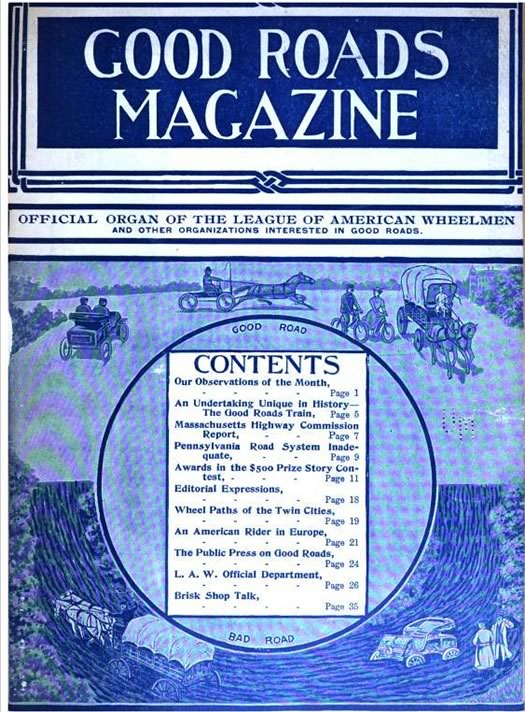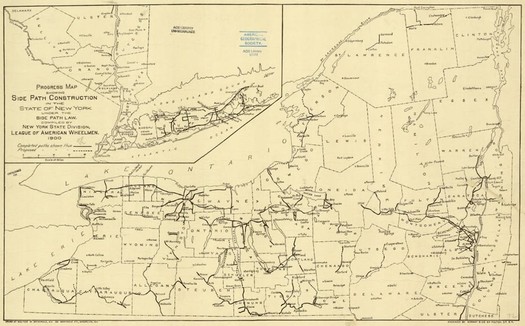When bikes weren't just something on the side

A 1900 map of "side paths" -- bike paths -- around the greater Albany area.
That recent post about the "great popularity of cycling" in Saratoga Springs around the early 1900s and the all the discussion of late about building protected bike lanes in Albany got us looking into the history of bike paths. And, as so often is the case, the past seems like a completely different place.
For example: There was once a law in New York State that allowed a group of just 50 bicyclists to petition for the formation of a commission that would be tasked with building bike lanes.
The golden age of bicycles

Two women stopped during a bicycle ride around 1900 in Schenectady. / photo: Larry Hart Collection, Schenectady County Historical Society, Grems-Doolittle Library
The late 1800s/very early 1900s were a particularly bicycle-happy time, as bicycles had recently evolved to become very much like the machines we have today. And bikes had a big cultural effect, allowing many people a degree of mobility that previously hadn't been available to them. Susan B. Anthony even lauded their effect: "I think [bicycling] has done more to emancipate women than anything else in the world."
The bicycle wasn't just a way to get around -- it was also a new form of leisure. Here's an 1896 New York Times report on a trip in which bicyclists from the NYC area were set to ride a boat to Albany and then cycle their way back downstate.
The Albany area was no exception to the bike craze. There were an estimated 5,000 bicycles in use in the city of Albany in 1900, according to a tourist guide book. And there are accounts of bicycle races drawing thousands of spectators to a track at the now-gone Island Park.
There were also multiple clubs and organizations related to cycling in the city, including the Albany Bicycle Club (formed by combining the Albany County Wheelmen and Fort Orange Wheelmen), Central Wheelmen, the North End Wheelmen, and the Triangle Cyclers. So successful was the Albany Bicycle Club that it had leased an "elegant mansion" on the corner of Lark and Lancaster as its headquarters.
Cycling as a political movement

via Google Books/University of Michigan
The rise of bicycle clubs was important because it provided a vehicle for cyclists to organize politically. And what would bicyclists want from politics? Better roads. Because riding your new, modern bicycle on a old, rutted, muddy road wasn't a good experience.
One organization in particular, the League of American Wheelmen, took the lead on this issue. It even published a magazine called Good Roads. And the league scored a notable victory when it successfully lobbied for the passage of a "side path" law in New York State in 1899.
(Albany County was even farther ahead of the curve -- it had adopted a similar law in 1898. A 1901 issue of Good Roads Magazine hailed the chair of Albany County's side path commission -- John D. Chism, Jr., also an Albany Bicycle Club official -- as being "most persistently aggressive" in promoting the issue.)
New York State's side path law laid out a framework for the process of constructing what were essentially bike lanes alongside roads. A county commission could be formed with the petitioning of 50 "resident wheelmen," and that commission could work toward constructing the paths. To help pay for the new paths, the law allowed for the sale of licenses for the price of no less than 50 cents and no more than a dollar. Users of the side paths were required to buy a license -- getting caught without one could mean a fine. (Here's a photo of an Albany County side path license.)
The network of side paths

This is the League of American Wheelmen map of side paths around New YOrk State in 1900. Here's a zoomable version. / via University of Wisconsin-Milwaukee Libraries
The greater Albany area had many side paths, that stretched from Albany out past Amsterdam and from Schenectady north past Saratoga Springs all the way to Bolton. At the Schenectady County Historical Society's Grems-Doolittle Library blog there's a description of how the side path between Albany and Schenectady worked:
During the 1890s, a cinder sidepath was built along the south side of Route 5 (State Street / Central Avenue) between Schenectady and Albany, and was made specifically for bicycles. Schenectady resident Russell Fradgley remembered paying $1.00 per year for a license to use the sidepath in 1903. "Spotters" were stationed along the route to check that a badge was visible on passing bicycles. Those without a badge were subject to a 10-cent toll. Fradgley, a member of the Albany Bicycle Club, earned several medals for one-day bike rides of more than 100 miles. "We often rode from Albany to about three miles west of Amsterdam, back to Albany, then to Schenectady and return. That would make up the 100 miles," he recalled. "We used the paths all the way and zipped past the traffic of that day. We had papers signed along the route to prove we made the trip."
The side path commissions were also in charge of figuring out problems like how to maintain the lanes. An issue of Good Roads from later in 1901 detailed how Albany County devised a way to keep weeds down on its cycle paths.
A 1901 issue of Good Roads remarked of side paths: "The cycle paths of Albany, Rochester, Minneapolis, Seattle and Spokane have done more to keep alive the fraternal feeling among cyclists and to boom the bicycle trade in those cities than any other issue elsewhere." And there was even talk of constructing a network of side paths that stretched across the nation so that "it will be possible for a wheelman to ride the entire distance between New York City and San Francisco without encountering a mile of bad riding except such as cannot be avoided on the paved streets of the big cities en route."
The decline
Of course, you know how this turns out. The dawn of the motor age quickly arrived. Bicycles, as well as trolleys, were overtaken. And the side path law was repealed.
Noted a 1917 edition of that Albany guide book mentioned above -- the one that had reported thousands of bicycles in Albany in 1900 -- of the city's once multiple bicycle clubs: "These all now are practically out of existence."
____
Earlier on AOA:
+ "The citizens of Saratoga, recognizing the great popularity of cycling..."
+ Riding the trolley -- everywhere
Say Something!
We'd really like you to take part in the conversation here at All Over Albany. But we do have a few rules here. Don't worry, they're easy. The first: be kind. The second: treat everyone else with the same respect you'd like to see in return. Cool? Great, post away. Comments are moderated so it might take a little while for your comment to show up. Thanks for being patient.
Comments
wow
... said ethan on Aug 26, 2015 at 8:10 AM | link
This article is a gem!
... said Jason on Aug 28, 2015 at 5:12 PM | link
Great article. Albany County did have licenses during 1898.
Sidepath League of Albany Co 3885 & 1132 exist.
I did not know the Sidepath law was repealed in 1908. Thank you. What date if known?
... said Eric on Sep 10, 2015 at 2:25 PM | link